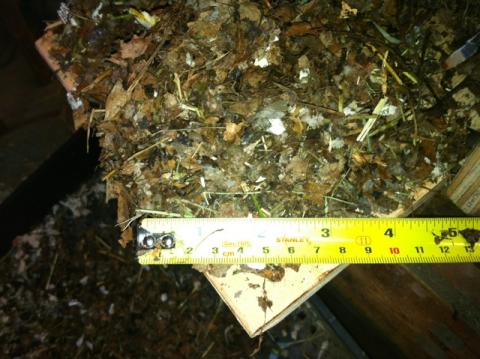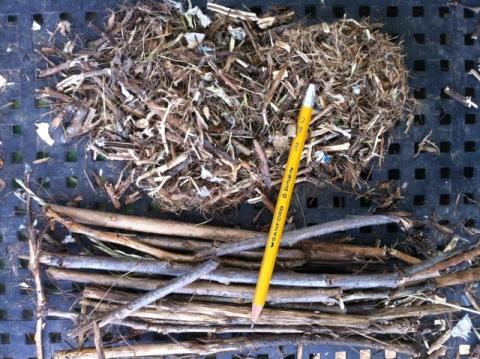Friends of the wet low pressure briquetting process;
We are seeing many who dive into making up briquettes with all kinds of new presses and blends but who lack a good understanding of what it takes to make a good solid briquette. They give up on use of agro residues because of frustration in getting them to compact, and then resort to use of paper.
Paper is a good shortcut but it cuts you out of the richness of diversity and sustainability of the natural biota thats there. Paper is easy to use just soak it for a few days and you have the base for blending in about anything Great BUT.you will then depend upon it for the future, and with the chemicals used in its manufacture, it is not the best material for combustion either.
With these few bits of experience to add I hope to encourage you to moveon to briquetting with natural resources
With the wet low pressure ambient temperature process (WLPATP ?), fibers are used to bind the materials together. Corn Starch Clay, wax, dung and other additives can bind of course but these may add cost and/or are not necessarily good combustibles.For most of us, its all about getting the material (grasses/ straws/ leaves /stalks/ husks /stems etc., to expose their fibers, and to then dissociate these fibers from their natural matrices, then randomly realigning them in the form of, say, matted hair or a really tight birds nest. (fiber length varies depending upon flexibility. from a few mm to a few cm) .
If processed correctly, natural fibers will flex and then tend to interlock once blended with other materials in a water slurry.
One does not achieve this by simple chopping or even direct use of the fiber without some form of softening (thru partial decompsition, in a hot humid anerobic environment, (under such as a black plastic bag), or as we are learning from our Mayan colleagues in Guatemala, use of agricultural lime (which is traditionally discarded after its use in hot water to soften and de-shell their corn kernals).
Before decompostion however, it is necessary to shred and tear the material apart into cornflake-sized pieces. Simple chopping does not generally do the trick, as it only reduces the size of the material but does expose and dissociate the fibers. The traditional mortar and pestle, found in much of the world, is probably the best implement to use technically but it mis also not the most culturally accepted or ergonomically efficient choice either.
Other methods include stomping on the mass in a tub of water (not unlke grape crushing in traditional Italy), or beating it in a guinea sack, or
beating it with a paint mixer chucked into an electric drill-- in a water filled oil drum with several labor intensive variants in between. To the opposite extreme, and for far higher produciton, others are running them through an 8 to 10 hp hammer mill.
Some have used augur presses to shred material and compact it at the same time but the risk with too much force is that the fibers are torn into fine dust in the process and the briquete falls apart. High pressure conventional preses generatin or heated to 400 deg F fo menting lignin in sawdust, are a disaster for this kind of briquetting. The water in the charge turns to steam and in turn creates a "steam cannon" shooting out biomass all over the place. I learned this in a trial next to a high end auto body shop in Malawi where the then life president/dictator's/ top end mercedes benz car was being re sprayed, with interesting results.
We developed a hand cranked Thresher Masher Chopper in Uganda in 2003-4 with fabrication assistance from the Uganda Industrial Research Institute, but it is prooving too costly and difficult to fabicate for most rural areas.
Our newer "Mini TMC", based on both the work of Lee Hites and JAn smith with Engineers without Borders professional chapter in Ohio, and research into traditional coffee shelling devices in Guatemala, is emerging now with about ten colleagues around the briquetting world. It seems form early tests ther and here in Obamaland, to achieve what you see below, using nothing more than used hacksaw blades, ordinaly heavy duty hand wire brushes, some contact cement and a old bike crank and pedal but it is likely going to emerge in several forms, according to local preferences, needs etc.more on that in a few months when we are sure it is relaible/ safe and easily replicated in a host of environments/ cultures etc etc., within the development network.
Back to the point: The material needs to look like what you see below, if you are going to make good briquettes. no matter what you are using.
Once you have this form of material and it has been softened so that it compacts nicely (not with a "spongy" or a the other end, " muddy", feel, it can be used as a good base for adding more granular carboniferous materials ( sawdust, charcoal fines / dust /crumbs off the seller's stall floor, rice husks etc.. The granular material can amp up the heat and change the charater of the burn from peat to wood to charcoal-like, -if and when you require that kind of heat.
In all cases though, if blended well, with well prepared agro residues, such granular combustible materials act acts as infilling, much the same way aggregate adds body to concrete. In the case of briquettemaking, it is the fibers which do the binding by encapsulating the granular material, locking it in place and densifying the whole mass in the process, when dried.
The force required to achieve this is seldom more than 10 bars 150 - 200 psi. Over a 4" dia briquete surface thats about one ton of force --relatively easy to achieve by any of several means. You have lots of options to choose from in that regard: There are now about 25 generically different kinds of hand presses out online for just about eny kind of resource, skill, cultural logistical situation.
In the main however, its not about just chopping and force !
enjoy,
Richard Stanley
http://www.legacyfound.org
Below: this is the output needed from ordinary yard wastes (resource:
dried/ browned out grasses, field straw, leaves and a bit of some scrap windblown newspaper tossed in as well



